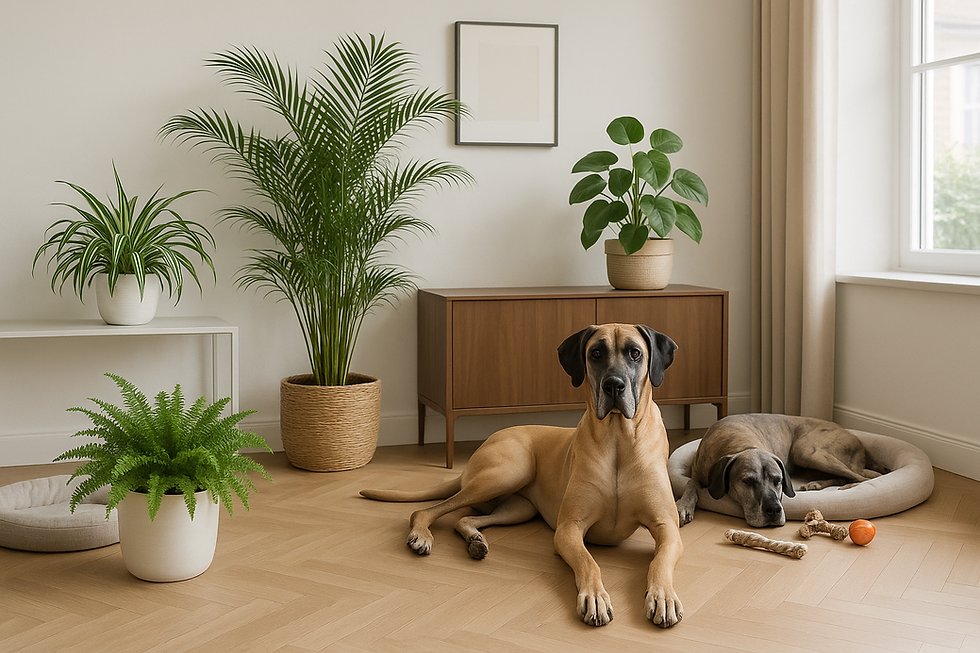Why Your Dog Needs an 'OFF' Switch - and how to teach it.
- Ariel Bolinger
- Jul 18
- 3 min read
As humans, we cherish our downtime—those quiet moments with coffee in hand, a book on the nightstand, or simply zoning out on the couch after a long day. We know the value of rest. But how often do we think about our dogs needing the same?
Most people don’t realize their dog’s brain works a lot like a toddler’s: full of energy, curiosity, and emotion—but without the ability to hit pause on their own. Without proper rest and mental balance, that sweet dog becomes a whirlwind of destruction: chewing up furniture, barking nonstop, pacing the yard, or digging like a backyard archaeologist. Sound familiar?
“My Dog Gets Plenty of Exercise—So Why Isn’t He Tired?”
This is a question I hear from clients all the time. Walks, fetch, backyard play—on paper, it sounds like the dog should be worn out. But often, these activities lack mental engagement and structure.
Think of it like this: You hop on a treadmill for two hours but don’t set a pace, focus, or posture. You’ve moved a lot, but your brain hasn’t checked in—and you don’t feel truly spent. The same applies to your dog. Physical exertion alone doesn’t relieve mental tension.
Balancing Physical and Mental Energy
Behavioral issues like chewing, barking, and digging are rarely the result of too little physical activity—they stem from a lack of mental stimulation and downtime.
Ask yourself:
Is your dog’s walk structured or a chaotic sniff-fest?
Does fetch include impulse control, or is it just constant throwing?
Is your dog alone in the backyard or engaging with you?
Without clear guidance and structure, your dog doesn’t know how to “shut off.” He’s not misbehaving—he’s coping the only way he knows how.
Training the “Off” Switch
Dogs weren’t bred for modern living—they were bred to work. Once their job was done, they naturally valued rest. But without that kind of purpose today, they struggle to decompress. That’s where training comes in.
Here are two powerful tools to help your dog build an off switch:
1. Down Dog (Meditative Rest)
This is your shared quiet time. On leash, guide your dog into a down next to you. Place the leash under your foot to keep it gently taut if your dog tries to move. Then… just sit. No talking. No direction. Let your dog exist in stillness with you.
It won’t be easy at first, especially for anxious or high-strung dogs. But with calm consistency, your dog will learn how to be still—and enjoy it.
2. Place Command (Solo Reset Button)
A reliable “place” command lets your dog retreat into calm on cue. Start with a designated area like an elevated cot bed. Gradually build up distractions—vacuuming, doorbells, guests—and reinforce calm behavior.
Eventually, your dog may place himself when he’s overwhelmed. This becomes a rewarding mental shift for your dog—a safe zone of peace he can enter anytime.
Why Structure Matters
Dogs thrive with clear expectations. Structure gives them a sense of purpose and confidence. When you create consistent routines—when to eat, play, walk, rest—your dog learns to trust your leadership and feels secure enough to relax.
Without it, dogs develop obsessive behaviors: guarding toys, spinning in circles, tearing up baseboards. These aren’t just bad habits—they’re signs of an overwhelmed mind lacking healthy outlets.

Final Thought
You wouldn’t expect a toddler to behave all day without a nap. Don’t expect your dog to either. Rest, calm, and stillness are as important as walks and toys. Teach your dog how to “turn off,” and you’ll build a happier, healthier companion—and a deeper bond.

Comments